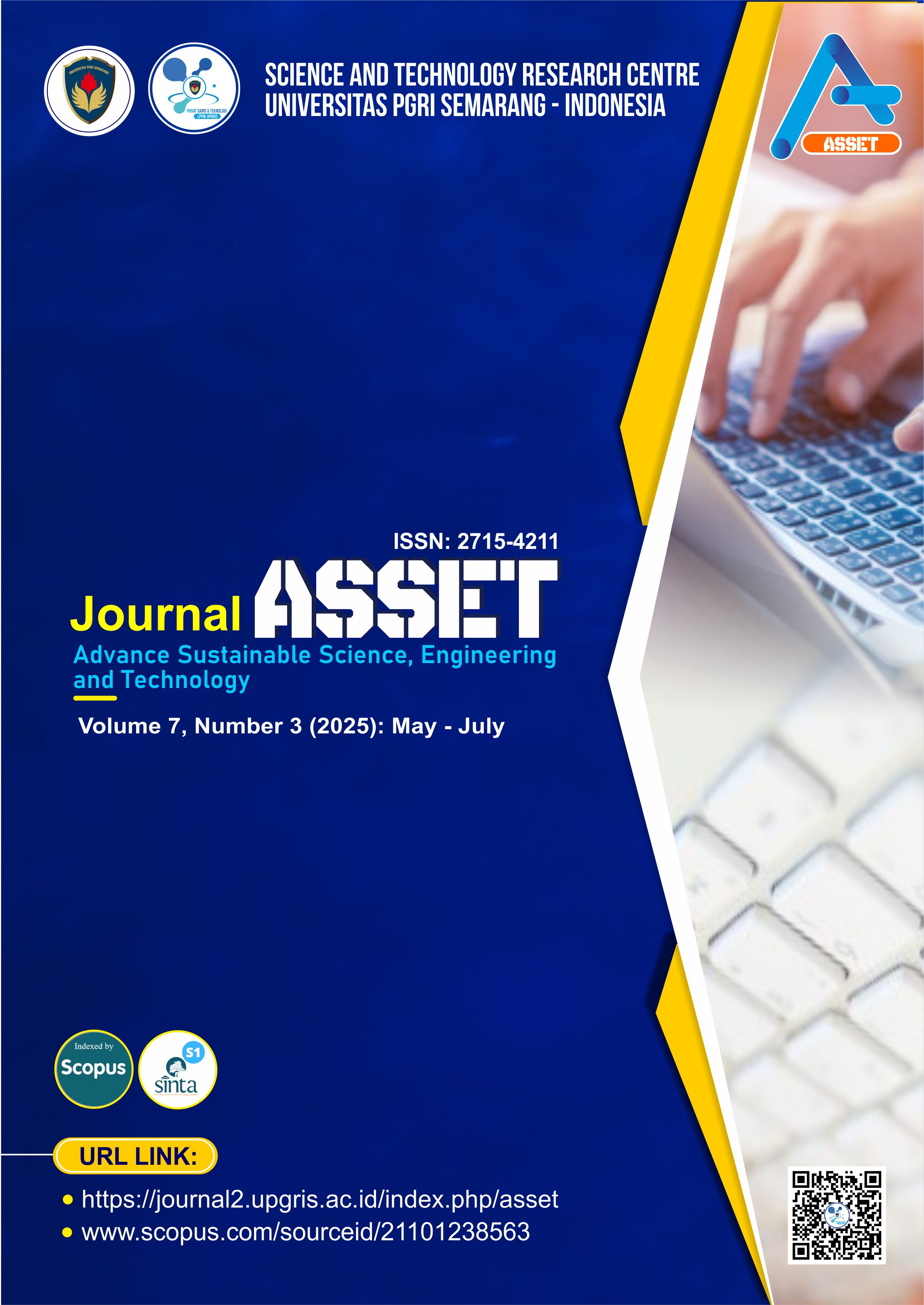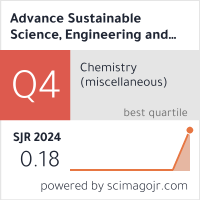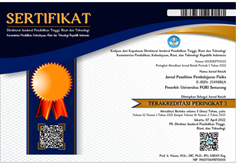Analysis Stability of Retaining Wall type Soldier Pile during Dewatering Work on Hospital Construction Site
DOI:
https://doi.org/10.26877/asset.v7i3.1809Keywords:
slope stability, dewatering, finite element analysis, geotechnical stability, soil mechanics, groundwater management systemAbstract
Groundwater subsidence during dewatering work can be a serious challenge if soil conditions are unstable, potentially disrupting the stability of supporting structures such as soil retaining walls. This research analyzed the stability of soldier pile type soil retaining walls during the dewatering process in hospital construction projects in the BSD area. The data used included the results of Standard Penetration Test (N-SPT), monitoring of dewatering work, inclinometer readings, and stability analysis using a 2D-based finite element software. The simulation results showed that the decrease in the groundwater level caused a change in lateral pressure on the retaining wall, with the maximum deformation reaching 2 m and the safety factor dropping from SF = 2.5 to SF = 2.2. If the analysis indicates a critical impact on stability (SF < 1.5 or deformation exceeding tolerances), then mitigation measures such as the installation of additional struts or dewatering system optimization are required. These findings provide technical guidance to minimize the risk of structural failure during the dewatering process on softsoils.
References
[1] W. Zhang, R. Zhang, W. Wang, F. Zhang, and A. T. C. Goh, “A Multivariate Adaptive Regression Splines model for determining horizontal wall deflection envelope for braced excavations in clays,” Tunn. Undergr. Sp. Technol., vol. 84, no. October 2017, pp. 461–471, 2019, doi: 10.1016/j.tust.2018.11.046.
[2] J. Sundell, E. Haaf, J. Tornborg, and L. Rosén, “Comprehensive risk assessment of groundwater drawdown induced subsidence,” Stoch. Environ. Res. Risk Assess., vol. 33, no. 2, pp. 427–449, 2019, doi: 10.1007/s00477-018-01647-x.
[3] D. Fan, Y. Tan, Y. Tang, and D. Wang, “Evaluation of dewatering-induced hydraulic and ground responses of thick multi-aquifer sandy strata without aquitards,” Environ. Earth Sci., vol. 83, no. 1, pp. 1–29, 2024, doi: 10.1007/s12665-023-11315-1.
[4] X. Liu et al., “Dewatering-Induced Stratified Settlement around Deep Excavation: Physical Model Study,” Appl. Sci., vol. 12, no. 18, 2022, doi: 10.3390/app12188929.
[5] C. F. Zeng, W. Powrie, C. J. Xu, and X. L. Xue, “Wall movement during dewatering inside a diaphragm wall before soil excavation,” Undergr. Sp., vol. 22, pp. 355–368, 2025, doi: 10.1016/j.undsp.2025.01.003.
[6] S. H. Hong, F. H. Lee, and K. Y. Yong, “Three-dimensional pile-soil interaction in soldier-piled excavations,” Comput. Geotech., vol. 30, no. 1, pp. 81–107, 2003, doi: 10.1016/S0266-352X(02)00028-9.
[7] A. Alsahly, J. Stascheit, and G. Meschke, “Advanced finite element modeling of excavation and advancement processes in mechanized tunneling,” Adv. Eng. Softw., vol. 100, pp. 198–214, 2016, doi: 10.1016/j.advengsoft.2016.07.011.
[8] W. G. Zhang and A. T. C. Goh, “Multivariate adaptive regression splines for analysis of geotechnical engineering systems,” Comput. Geotech., vol. 48, pp. 82–95, 2013, doi: 10.1016/j.compgeo.2012.09.016.
[9] R. B. J. Brinkgreve, W. Broere, and D. Waterman, “Plaxis 2D Manual - Version 8,” no. January, p. 16, 2006.
[10] L. Li and M. Yang, “International Society for Soil Mechanics and Foundation Engineering News,” Géotechnique, vol. 24, no. 3, pp. 451–451, 1974, doi: 10.1680/geot.1974.24.3.451.
[11] Y. Liu, Y. Zhao, D. Zhang, and Z. Liu, “The long-term mechanical performance of geogrid-reinforced soil retaining walls under cyclic footing loading,” Case Stud. Constr. Mater., vol. 17, no. November, p. e01642, 2022, doi: 10.1016/j.cscm.2022.e01642.
[12] S. Lines, D. J. Williams, and S. A. Galindo-Torres, “Determination of Thermal Conductivity of Soil Using Standard Cone Penetration Test,” Energy Procedia, vol. 118, pp. 172–178, 2017, doi: 10.1016/j.egypro.2017.07.036.
[13] P. Liu, R. Zhu, F. Zhao, and Y. Zhao, “Enhancing Dispersive Soil: An Experimental Study on the Efficacy of Microbial, Electrokinetics, and Chemical Approaches,” Sustain., vol. 16, no. 23, 2024, doi: 10.3390/su162310425.
[14] L. Zhao, Z. Zhong, B. Zhao, Z. Zeng, X. Gong, and S. Hu, “Analysis of the Active Earth Pressure of Sandy Soil under the Translational Failure Mode of Rigid Retaining Walls Near Slopes,” KSCE J. Civ. Eng., vol. 28, no. 12, pp. 5500–5515, 2024, doi: 10.1007/s12205-024-0846-5.
[15] T. P. Wibowo and T. E. Wulandari, “Analisis Stabilitas Struktur Retaining Wall Basement Terhadap Tekanan Tanah Dengan Aplikasi Plaxis 8.6.,” J. Ilm. Tek. Sipil dan Arsit., vol. 2, no. 1, pp. 14–22, 2023, doi: 10.31289/jitas.v2i1.1942.
[16] Y. liang Lin, Z. Zhang, Y. hua Zhou, J. yi Duan, and G. lin Yang, “Investigation on lateral pressure on a sheet-pile wall with EPS layer supporting an expansive soil slope,” Case Stud. Constr. Mater., vol. 21, no. June, p. e03945, 2024, doi: 10.1016/j.cscm.2024.e03945.
[17] J. jing Wei, H. Liao, L. li Liu, and J. qun Zhu, “Seismic Factor of Safety for 3D Reinforced Soil Slope with Piles under Unsaturated Condition,” KSCE J. Civ. Eng., vol. 26, no. 9, pp. 3789–3802, 2022, doi: 10.1007/s12205-022-1711-z.
[18] Z. Liang, J. Xu, H. Cao, Y. Zeng, and T. Wu, “Theoretical study on the mechanism of slope sliding resistance and sliding force on multi-field coupling instability,” Ain Shams Eng. J., vol. 15, no. 12, p. 103072, 2024, doi: 10.1016/j.asej.2024.103072.
[19] D. Shah, “Stability Analysis of Gravity Retaining Wall by DEM Simulation,” no. October, pp. 4–9, 2024, doi: 10.56472/25839233/IJAST-V2I4P101.
[20] M. Preene, “Groundwater control for construction,” Proc. Inst. Civ. Eng. - Water Manag., vol. 161, no. 6, pp. 323–331, Dec. 2008, doi: 10.1680/wama.2008.161.6.323.
[21] L. Rohmah and E. Aryanny, “Risk Mitigation in Cold Chain Sytem using ANP and FMEA : A Case Study of PT XYZ,” Adv. Sustain. Sci. Eng. Technol., vol. 6, no. 4, p. 0240405, 2024, doi: 10.26877/asset.v6i4.690.











